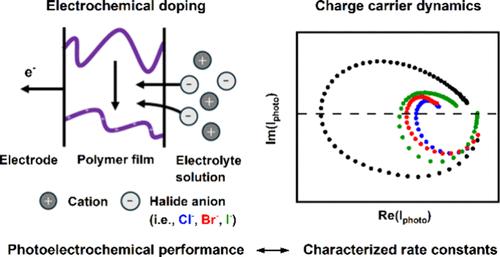掺杂对光电电池中半导体聚合物聚苯并(1,2-b:4,5-b ')二噻吩-二酮(PBDB-T)光致载流子动力学的影响
IF 4.6
2区 化学
Q2 CHEMISTRY, PHYSICAL
引用次数: 0
摘要
基于聚合物半导体的光电化学电池是太阳能到燃料转换的可行平台,但优化光电产生的电荷传输仍然是一个关键挑战。了解和控制这些载流子动力学对于提高器件效率至关重要。在这里,我们报道了一种半导体聚合物聚苯并(1,2-b:4,5-b ')二噻吩-二酮(PBDB-T)的电化学掺杂,有效地提高了光电化学活性。我们系统地研究了掺杂物种(Cl -, Br -和I -)对载流子动力学的影响,使用强度调制光电流光谱(IMPS)。我们的研究结果表明:(1)所有卤化物掺杂都加速了电荷转移和重组动力学,(2)电荷转移速率的较大相对增加导致电荷转移效率的整体提高,(3)Cl -掺杂产生最大的光电流增强,这归因于有效的激子分离。这些发现对掺杂特性如何影响载流子动力学提供了有价值的见解,并为通过控制电化学掺杂设计高性能有机光电极提供了策略。本文章由计算机程序翻译,如有差异,请以英文原文为准。

Effect of Doping on Photoinduced Charge Carrier Dynamics of a Semiconducting Polymer, Poly(benzo(1,2-b:4,5-b′)dithiophene-alt-dione) (PBDB-T), in Photoelectrochemical Cells
Photoelectrochemical cells based on polymer semiconductors are a viable platform for solar-to-fuel conversion, yet optimizing photogenerated charge transport remains a key challenge. Understanding and controlling these charge carrier dynamics are critical for advancing device efficiency. Here, we report that electrochemical doping of a semiconducting polymer, poly(benzo(1,2-b:4,5-b′)dithiophene-alt-dione) (PBDB-T), effectively enhances photoelectrochemical activity. We systematically investigate the influence of doping species (Cl–, Br–, and I–) on charge carrier dynamics using intensity-modulated photocurrent spectroscopy (IMPS). Our results indicate that (1) all halide dopants accelerate both charge transfer and recombination kinetics, (2) the greater relative increase in the charge transfer rate leads to an overall improvement in charge transfer efficiency, and (3) Cl– doping yields the highest photocurrent enhancement, which is attributed to efficient exciton separation. These findings provide valuable insight into how dopant identity influences charge carrier dynamics and offer a strategy for designing high-performance organic photoelectrodes through controlled electrochemical doping.
求助全文
通过发布文献求助,成功后即可免费获取论文全文。
去求助
来源期刊

The Journal of Physical Chemistry Letters
CHEMISTRY, PHYSICAL-NANOSCIENCE & NANOTECHNOLOGY
CiteScore
9.60
自引率
7.00%
发文量
1519
审稿时长
1.6 months
期刊介绍:
The Journal of Physical Chemistry (JPC) Letters is devoted to reporting new and original experimental and theoretical basic research of interest to physical chemists, biophysical chemists, chemical physicists, physicists, material scientists, and engineers. An important criterion for acceptance is that the paper reports a significant scientific advance and/or physical insight such that rapid publication is essential. Two issues of JPC Letters are published each month.
 求助内容:
求助内容: 应助结果提醒方式:
应助结果提醒方式:


